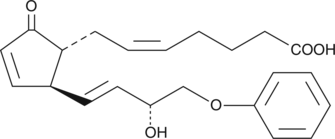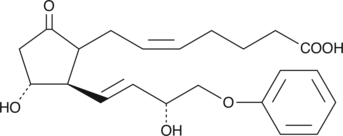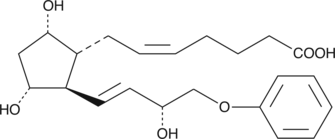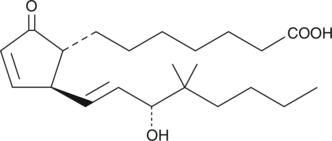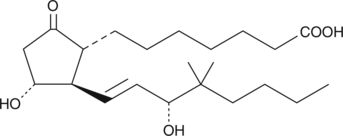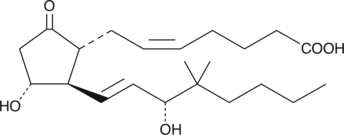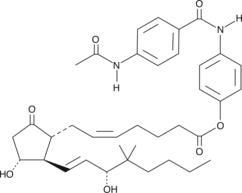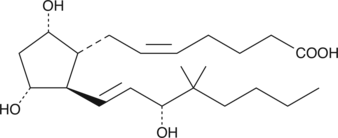Chemicals
Showing 3751–3900 of 41137 results
-
16-Oxokahweol is a synthetic diterpene and derivative of kahweol (Item No. 14015).{53495} It increases cytosolic glutathione S-transferase (GST) activity and acid-soluble sulfhydryl levels in mouse liver and small bowel mucosa when administered at a dose of 10 µmol/animal once per day for three days.
Brand:CaymanSKU:30117 - 1 mgAvailable on backorder
16-Oxokahweol is a synthetic diterpene and derivative of kahweol (Item No. 14015).{53495} It increases cytosolic glutathione S-transferase (GST) activity and acid-soluble sulfhydryl levels in mouse liver and small bowel mucosa when administered at a dose of 10 µmol/animal once per day for three days.
Brand:CaymanSKU:30117 - 10 mgAvailable on backorder
16-Oxokahweol is a synthetic diterpene and derivative of kahweol (Item No. 14015).{53495} It increases cytosolic glutathione S-transferase (GST) activity and acid-soluble sulfhydryl levels in mouse liver and small bowel mucosa when administered at a dose of 10 µmol/animal once per day for three days.
Brand:CaymanSKU:30117 - 5 mgAvailable on backorder
Prostaglandin F2α (PGF2α), acting through the FP receptor, causes smooth muscle contraction and exhibits potent luteolytic activity.{187,421,1651} 16-phenoxy PGF2α is a metabolically stable analog of PGF2α. It binds to the FP receptor on ovine luteal cells with much greater affinity (440%) than PGF2α.{2058} Ethyl amides of PGs serve as prodrugs, as they are hydrolyzed in certain tissues to generate the bioactive free acid.
Brand:CaymanSKU:10009875 - 1 mgAvailable on backorder
Prostaglandin F2α (PGF2α), acting through the FP receptor, causes smooth muscle contraction and exhibits potent luteolytic activity.{187,421,1651} 16-phenoxy PGF2α is a metabolically stable analog of PGF2α. It binds to the FP receptor on ovine luteal cells with much greater affinity (440%) than PGF2α.{2058} Ethyl amides of PGs serve as prodrugs, as they are hydrolyzed in certain tissues to generate the bioactive free acid.
Brand:CaymanSKU:10009875 - 10 mgAvailable on backorder
Prostaglandin F2α (PGF2α), acting through the FP receptor, causes smooth muscle contraction and exhibits potent luteolytic activity.{187,421,1651} 16-phenoxy PGF2α is a metabolically stable analog of PGF2α. It binds to the FP receptor on ovine luteal cells with much greater affinity (440%) than PGF2α.{2058} Ethyl amides of PGs serve as prodrugs, as they are hydrolyzed in certain tissues to generate the bioactive free acid.
Brand:CaymanSKU:10009875 - 5 mgAvailable on backorder
16-phenoxy tetranor PGA2 is a minor metabolite found in human plasma after intravenous administration of sulprostone.{3387} Its biological activity has not been studied or reported in the literature.
Brand:CaymanSKU:10285 - 1 mgAvailable on backorder
16-phenoxy tetranor PGA2 is a minor metabolite found in human plasma after intravenous administration of sulprostone.{3387} Its biological activity has not been studied or reported in the literature.
Brand:CaymanSKU:10285 - 10 mgAvailable on backorder
16-phenoxy tetranor PGA2 is a minor metabolite found in human plasma after intravenous administration of sulprostone.{3387} Its biological activity has not been studied or reported in the literature.
Brand:CaymanSKU:10285 - 5 mgAvailable on backorder
16-phenoxy tetranor PGE2 is the free acid form of sulprostone formed by the hydrolysis of the methylsulfonamide bond.{3387} 16-phenoxy tetranor PGE2 is a minor metabolite of sulprostone found in human plasma after parenteral administration of the drug.{3387}
Brand:CaymanSKU:-16-phenoxy tetranor PGE2 is the free acid form of sulprostone formed by the hydrolysis of the methylsulfonamide bond.{3387} 16-phenoxy tetranor PGE2 is a minor metabolite of sulprostone found in human plasma after parenteral administration of the drug.{3387}
Brand:CaymanSKU:-16-phenoxy tetranor PGE2 is the free acid form of sulprostone formed by the hydrolysis of the methylsulfonamide bond.{3387} 16-phenoxy tetranor PGE2 is a minor metabolite of sulprostone found in human plasma after parenteral administration of the drug.{3387}
Brand:CaymanSKU:-16-phenoxy PGF2α is a metabolically stable analog of PGF2α. It binds to the FP receptor on ovine luteal cells with much greater affinity (440%) than PGF2α.{2058}
Brand:CaymanSKU:-Out of stock
16-phenoxy PGF2α is a metabolically stable analog of PGF2α. It binds to the FP receptor on ovine luteal cells with much greater affinity (440%) than PGF2α.{2058}
Brand:CaymanSKU:-Out of stock
16-phenoxy PGF2α is a metabolically stable analog of PGF2α. It binds to the FP receptor on ovine luteal cells with much greater affinity (440%) than PGF2α.{2058}
Brand:CaymanSKU:-Out of stock
Prostaglandin F2α (PGF2α) drives luteolysis and smooth muscle contraction by activating the FP receptor. Stable, lipophilic analogs of PGF2α are used to modulate luteolysis and treat glaucoma. 16-phenoxy tetranor Prostaglandin F2α isopropyl ester (16-phenoxy tetranor PGF2α isopropyl ester) is a lipophilic analog of 16-phenoxy tetranor PGF2α. Isopropyl esters of PGs serve as prodrugs, as they are efficiently hydrolyzed in certain tissues to generate the bioactive free acid.
Brand:CaymanSKU:10010103 - 1 mgAvailable on backorder
Prostaglandin F2α (PGF2α) drives luteolysis and smooth muscle contraction by activating the FP receptor. Stable, lipophilic analogs of PGF2α are used to modulate luteolysis and treat glaucoma. 16-phenoxy tetranor Prostaglandin F2α isopropyl ester (16-phenoxy tetranor PGF2α isopropyl ester) is a lipophilic analog of 16-phenoxy tetranor PGF2α. Isopropyl esters of PGs serve as prodrugs, as they are efficiently hydrolyzed in certain tissues to generate the bioactive free acid.
Brand:CaymanSKU:10010103 - 10 mgAvailable on backorder
Prostaglandin F2α (PGF2α) drives luteolysis and smooth muscle contraction by activating the FP receptor. Stable, lipophilic analogs of PGF2α are used to modulate luteolysis and treat glaucoma. 16-phenoxy tetranor Prostaglandin F2α isopropyl ester (16-phenoxy tetranor PGF2α isopropyl ester) is a lipophilic analog of 16-phenoxy tetranor PGF2α. Isopropyl esters of PGs serve as prodrugs, as they are efficiently hydrolyzed in certain tissues to generate the bioactive free acid.
Brand:CaymanSKU:10010103 - 5 mgAvailable on backorder
Prostaglandin F2α (PGF2α) drives luteolysis and smooth muscle contraction by activating the FP receptor. Stable, lipophilic analogs of PGF2α are used to modulate luteolysis and treat glaucoma. 16-phenoxy tetranor Prostaglandin F2α isopropyl ester (16-phenoxy tetranor PGF2α isopropyl ester) is a lipophilic analog of 16-phenoxy tetranor PGF2α. Isopropyl esters of PGs serve as prodrugs, as they are efficiently hydrolyzed in certain tissues to generate the bioactive free acid.
Brand:CaymanSKU:10010103 - 500 µgAvailable on backorder
Prostaglandin F2α (PGF2α) drives luteolysis and smooth muscle contraction by activating the FP receptor. Stable, lipophilic analogs of PGF2α are used to modulate luteolysis and treat glaucoma. 16-phenoxy tetranor Prostaglandin F2α (16-phenoxy tetranor PGF2α) is a metabolically stable form of PGF2α containing a 16-phenoxy group at the ω-terminus. It binds to the FP receptor on ovine luteal cells with much greater affinity (440%) than PGF2α.{2058} 16-phenoxy tetranor PGF2α methyl ester is a lipophilic analog of 16-phenoxy tetranor PGF2α. Methyl esters of PGs serve as prodrugs, as they are efficiently hydrolyzed in certain tissues to generate the bioactive free acid.
Brand:CaymanSKU:10010102 - 1 mgAvailable on backorder
Prostaglandin F2α (PGF2α) drives luteolysis and smooth muscle contraction by activating the FP receptor. Stable, lipophilic analogs of PGF2α are used to modulate luteolysis and treat glaucoma. 16-phenoxy tetranor Prostaglandin F2α (16-phenoxy tetranor PGF2α) is a metabolically stable form of PGF2α containing a 16-phenoxy group at the ω-terminus. It binds to the FP receptor on ovine luteal cells with much greater affinity (440%) than PGF2α.{2058} 16-phenoxy tetranor PGF2α methyl ester is a lipophilic analog of 16-phenoxy tetranor PGF2α. Methyl esters of PGs serve as prodrugs, as they are efficiently hydrolyzed in certain tissues to generate the bioactive free acid.
Brand:CaymanSKU:10010102 - 5 mgAvailable on backorder
Prostaglandin F2α (PGF2α) drives luteolysis and smooth muscle contraction by activating the FP receptor. Stable, lipophilic analogs of PGF2α are used to modulate luteolysis and treat glaucoma. 16-phenoxy tetranor Prostaglandin F2α (16-phenoxy tetranor PGF2α) is a metabolically stable form of PGF2α containing a 16-phenoxy group at the ω-terminus. It binds to the FP receptor on ovine luteal cells with much greater affinity (440%) than PGF2α.{2058} 16-phenoxy tetranor PGF2α methyl ester is a lipophilic analog of 16-phenoxy tetranor PGF2α. Methyl esters of PGs serve as prodrugs, as they are efficiently hydrolyzed in certain tissues to generate the bioactive free acid.
Brand:CaymanSKU:10010102 - 500 µgAvailable on backorder
16,16-dimethyl PGA1 is a metabolism resistant analog of PGA1. In vitro, it inhibits the viral replication in both HSV and HIV-1 infection systems at concentrations that do not adversely alter cellular DNA synthesis. The ID50 for HSV-1 strains in Vero cells and human foreskin fibroblasts are 3.8-5.6 µg/ml and 4.6-7.3 µg/ml, respectively. The ID50 for T cells acutely infected with HIV-1 is 2.5 µg/ml.{811}
Brand:CaymanSKU:10080 - 1 mgAvailable on backorder
16,16-dimethyl PGA1 is a metabolism resistant analog of PGA1. In vitro, it inhibits the viral replication in both HSV and HIV-1 infection systems at concentrations that do not adversely alter cellular DNA synthesis. The ID50 for HSV-1 strains in Vero cells and human foreskin fibroblasts are 3.8-5.6 µg/ml and 4.6-7.3 µg/ml, respectively. The ID50 for T cells acutely infected with HIV-1 is 2.5 µg/ml.{811}
Brand:CaymanSKU:10080 - 10 mgAvailable on backorder
16,16-dimethyl PGA1 is a metabolism resistant analog of PGA1. In vitro, it inhibits the viral replication in both HSV and HIV-1 infection systems at concentrations that do not adversely alter cellular DNA synthesis. The ID50 for HSV-1 strains in Vero cells and human foreskin fibroblasts are 3.8-5.6 µg/ml and 4.6-7.3 µg/ml, respectively. The ID50 for T cells acutely infected with HIV-1 is 2.5 µg/ml.{811}
Brand:CaymanSKU:10080 - 5 mgAvailable on backorder
16,16-dimethyl PGA2 is a metabolism-resistant analog of PGA2 with a prolonged in vivo half-life. It inhibits the proliferation of Sendai virus in cultured African green monkey kidney cells by >90% at a concentration of 4 µg/ml.{2680} Daily infusion of 10 µg of 16,16-dimethyl PGA2 methyl ester into mice infected with influenza A virus increased survival by 40%.{1136} Similar treatment of mice inoculated with erythroleukemia cells delayed tumor growth and increased survival time.{1184}
Brand:CaymanSKU:10280 - 1 mgAvailable on backorder
16,16-dimethyl PGA2 is a metabolism-resistant analog of PGA2 with a prolonged in vivo half-life. It inhibits the proliferation of Sendai virus in cultured African green monkey kidney cells by >90% at a concentration of 4 µg/ml.{2680} Daily infusion of 10 µg of 16,16-dimethyl PGA2 methyl ester into mice infected with influenza A virus increased survival by 40%.{1136} Similar treatment of mice inoculated with erythroleukemia cells delayed tumor growth and increased survival time.{1184}
Brand:CaymanSKU:10280 - 10 mgAvailable on backorder
16,16-dimethyl PGA2 is a metabolism-resistant analog of PGA2 with a prolonged in vivo half-life. It inhibits the proliferation of Sendai virus in cultured African green monkey kidney cells by >90% at a concentration of 4 µg/ml.{2680} Daily infusion of 10 µg of 16,16-dimethyl PGA2 methyl ester into mice infected with influenza A virus increased survival by 40%.{1136} Similar treatment of mice inoculated with erythroleukemia cells delayed tumor growth and increased survival time.{1184}
Brand:CaymanSKU:10280 - 5 mgAvailable on backorder
16,16-dimethyl PGD2 is a metabolically stable synthetic analog of PGD2. It enhances ADP-induced human platelet aggregation and increases systemic blood pressure in rats.
Brand:CaymanSKU:12750 - 1 mgAvailable on backorder
16,16-dimethyl PGD2 is a metabolically stable synthetic analog of PGD2. It enhances ADP-induced human platelet aggregation and increases systemic blood pressure in rats.
Brand:CaymanSKU:12750 - 10 mgAvailable on backorder
16,16-dimethyl PGD2 is a metabolically stable synthetic analog of PGD2. It enhances ADP-induced human platelet aggregation and increases systemic blood pressure in rats.
Brand:CaymanSKU:12750 - 5 mgAvailable on backorder
16,16-dimethyl PGD2 is a metabolically stable synthetic analog of PGD2. It enhances ADP-induced human platelet aggregation and increases systemic blood pressure in rats.
Brand:CaymanSKU:12750 - 500 µgAvailable on backorder
16,16-dimethyl PGE1 is a metabolically stable synthetic analog of PGE1. It induces human vascular smooth muscle contractions in vitro. It is 2, 3, and 6 times more potent than PGF2α in contracting tracheal, bronchial, and bronchiolar smooth muscle, respectively.{2218}
Brand:CaymanSKU:-16,16-dimethyl PGE1 is a metabolically stable synthetic analog of PGE1. It induces human vascular smooth muscle contractions in vitro. It is 2, 3, and 6 times more potent than PGF2α in contracting tracheal, bronchial, and bronchiolar smooth muscle, respectively.{2218}
Brand:CaymanSKU:-16,16-dimethyl PGE1 is a metabolically stable synthetic analog of PGE1. It induces human vascular smooth muscle contractions in vitro. It is 2, 3, and 6 times more potent than PGF2α in contracting tracheal, bronchial, and bronchiolar smooth muscle, respectively.{2218}
Brand:CaymanSKU:-16,16-dimethyl PGE2 is a competitive inhibitor of 15-hydroxy PGDH, but it is not a substrate for the enzyme.{1789} Because of its resistance to metabolism by 15-hydroxy PGDH, it has a prolonged half-life in vivo. 16,16-dimethyl PGE2 acts as an agonist on most EP receptor subtypes, and has been used experimentally to induce cervical ripening, uterine contraction, and prevent ulceration of the gastric mucosa in rats and dogs.{437,1422} The Kd for activation of isolated EP2 receptors is about 1 nM.{1422} 16,16-dimethyl PGE2 can be used to preserve the self-renewal properties while preventing the differentiation of hematopoietic stem cells during expansion in culture.{27133,27095}
Brand:CaymanSKU:-16,16-dimethyl PGE2 is a competitive inhibitor of 15-hydroxy PGDH, but it is not a substrate for the enzyme.{1789} Because of its resistance to metabolism by 15-hydroxy PGDH, it has a prolonged half-life in vivo. 16,16-dimethyl PGE2 acts as an agonist on most EP receptor subtypes, and has been used experimentally to induce cervical ripening, uterine contraction, and prevent ulceration of the gastric mucosa in rats and dogs.{437,1422} The Kd for activation of isolated EP2 receptors is about 1 nM.{1422} 16,16-dimethyl PGE2 can be used to preserve the self-renewal properties while preventing the differentiation of hematopoietic stem cells during expansion in culture.{27133,27095}
Brand:CaymanSKU:-16,16-dimethyl PGE2 is a competitive inhibitor of 15-hydroxy PGDH, but it is not a substrate for the enzyme.{1789} Because of its resistance to metabolism by 15-hydroxy PGDH, it has a prolonged half-life in vivo. 16,16-dimethyl PGE2 acts as an agonist on most EP receptor subtypes, and has been used experimentally to induce cervical ripening, uterine contraction, and prevent ulceration of the gastric mucosa in rats and dogs.{437,1422} The Kd for activation of isolated EP2 receptors is about 1 nM.{1422} 16,16-dimethyl PGE2 can be used to preserve the self-renewal properties while preventing the differentiation of hematopoietic stem cells during expansion in culture.{27133,27095}
Brand:CaymanSKU:-The p-(p-acetamidobenzamido) phenyl ester is a crystalline derivative of 16,16-dimethyl PGE2 and a potential prodrug.
Brand:CaymanSKU:-The p-(p-acetamidobenzamido) phenyl ester is a crystalline derivative of 16,16-dimethyl PGE2 and a potential prodrug.
Brand:CaymanSKU:-The p-(p-acetamidobenzamido) phenyl ester is a crystalline derivative of 16,16-dimethyl PGE2 and a potential prodrug.
Brand:CaymanSKU:-The p-(p-acetamidobenzamido) phenyl ester is a crystalline derivative of 16,16-dimethyl PGE2 and a potential prodrug.
Brand:CaymanSKU:-16,16-dimethyl PGF2α is a metabolically stable analog of PGF2α. It binds to the FP receptor on ovine luteal cells with slightly better affinity (159%) than PGF2α.{2058}
Brand:CaymanSKU:-Out of stock
16,16-dimethyl PGF2α is a metabolically stable analog of PGF2α. It binds to the FP receptor on ovine luteal cells with slightly better affinity (159%) than PGF2α.{2058}
Brand:CaymanSKU:-Out of stock
16,16-dimethyl PGF2α is a metabolically stable analog of PGF2α. It binds to the FP receptor on ovine luteal cells with slightly better affinity (159%) than PGF2α.{2058}
Brand:CaymanSKU:-Out of stock
16,16-dimethyl PGF2β is a metabolically stable analog of PGF2β. It prevents bronchospasm in asthmatics but is less potent than PGE2.{6596}
Brand:CaymanSKU:-Out of stock
16,16-dimethyl PGF2β is a metabolically stable analog of PGF2β. It prevents bronchospasm in asthmatics but is less potent than PGE2.{6596}
Brand:CaymanSKU:-Out of stock
16,16-dimethyl PGF2β is a metabolically stable analog of PGF2β. It prevents bronchospasm in asthmatics but is less potent than PGE2.{6596}
Brand:CaymanSKU:-Out of stock
Prostaglandin I2 is an unstable prostanoid which, through the ‘I prostanoid’ (IP) receptor, inhibits platelet aggregation and promotes vasodilatation in pulmonary vascular beds. AFP 07 is a 7,7-difluoroprostacyclin derivative that acts as a selective and highly potent agonist for the IP receptor (Ki = 0.561 nM).{7236} AFP 07 shows weaker affinity for EP receptors, with Ki values > 100 nM for EP1-3 and > 10 nM for EP4.{7236,15488} 16(R)-AFP 07 is an epimer of AFP 07. Its biological properties, particularly through the IP and EP receptors, remain to be evaluated.
Brand:CaymanSKU:10991 - 1 mgAvailable on backorder
Prostaglandin I2 is an unstable prostanoid which, through the ‘I prostanoid’ (IP) receptor, inhibits platelet aggregation and promotes vasodilatation in pulmonary vascular beds. AFP 07 is a 7,7-difluoroprostacyclin derivative that acts as a selective and highly potent agonist for the IP receptor (Ki = 0.561 nM).{7236} AFP 07 shows weaker affinity for EP receptors, with Ki values > 100 nM for EP1-3 and > 10 nM for EP4.{7236,15488} 16(R)-AFP 07 is an epimer of AFP 07. Its biological properties, particularly through the IP and EP receptors, remain to be evaluated.
Brand:CaymanSKU:10991 - 5 mgAvailable on backorder
Prostaglandin I2 is an unstable prostanoid which, through the ‘I prostanoid’ (IP) receptor, inhibits platelet aggregation and promotes vasodilatation in pulmonary vascular beds. AFP 07 is a 7,7-difluoroprostacyclin derivative that acts as a selective and highly potent agonist for the IP receptor (Ki = 0.561 nM).{7236} AFP 07 shows weaker affinity for EP receptors, with Ki values > 100 nM for EP1-3 and > 10 nM for EP4.{7236,15488} 16(R)-AFP 07 is an epimer of AFP 07. Its biological properties, particularly through the IP and EP receptors, remain to be evaluated.
Brand:CaymanSKU:10991 - 500 µgAvailable on backorder
Electrolyte and fluid transport in the kidney are regulated in part by arachidonic acid and its metabolites. 16-HETE is a minor CYP450 metabolite of arachidonic acid released by the kidney upon angiotensin II stimulation that demonstrates stereospecific biological activity. Electrolyte and fluid transport in the kidney are regulated in part by arachidonic acid and its metabolites. 16-HETE is a minor CYP450 metabolite of arachidonic acid released by the kidney upon angiotensin II stimulation that demonstrates stereospecific biological activity. 16(S)-HETE inhibits proximal tubule ATPase activity by as much as 60% at a concentration of 2 µM.{3825}
Brand:CaymanSKU:10004385 - 100 µgAvailable on backorder
Electrolyte and fluid transport in the kidney are regulated in part by arachidonic acid and its metabolites. 16-HETE is a minor CYP450 metabolite of arachidonic acid released by the kidney upon angiotensin II stimulation that demonstrates stereospecific biological activity. Electrolyte and fluid transport in the kidney are regulated in part by arachidonic acid and its metabolites. 16-HETE is a minor CYP450 metabolite of arachidonic acid released by the kidney upon angiotensin II stimulation that demonstrates stereospecific biological activity. 16(S)-HETE inhibits proximal tubule ATPase activity by as much as 60% at a concentration of 2 µM.{3825}
Brand:CaymanSKU:10004385 - 25 µgAvailable on backorder
Electrolyte and fluid transport in the kidney are regulated in part by arachidonic acid and its metabolites. 16-HETE is a minor CYP450 metabolite of arachidonic acid released by the kidney upon angiotensin II stimulation that demonstrates stereospecific biological activity. Electrolyte and fluid transport in the kidney are regulated in part by arachidonic acid and its metabolites. 16-HETE is a minor CYP450 metabolite of arachidonic acid released by the kidney upon angiotensin II stimulation that demonstrates stereospecific biological activity. 16(S)-HETE inhibits proximal tubule ATPase activity by as much as 60% at a concentration of 2 µM.{3825}
Brand:CaymanSKU:10004385 - 50 µgAvailable on backorder
Iloprost is a second generation structural analog of prostacyclin (PGI2) with about ten-fold greater potency than the first generation stable analogs, typified by carbaprostacyclin.{3347} Iloprost binds with equal affinity to the recombinant human IP and EP1 receptors with a Ki value of 11 nM.{8322} Most preparations of iloprost contain 16(S) and 16(R) stereoisomers. 16(R)-Iloprost inhibits platelet aggregation with an IC50 value of 65 nM.{16394}
Brand:CaymanSKU:-Iloprost is a second generation structural analog of prostacyclin (PGI2) with about ten-fold greater potency than the first generation stable analogs, typified by carbaprostacyclin.{3347} Iloprost binds with equal affinity to the recombinant human IP and EP1 receptors with a Ki value of 11 nM.{8322} Most preparations of iloprost contain 16(S) and 16(R) stereoisomers. 16(R)-Iloprost inhibits platelet aggregation with an IC50 value of 65 nM.{16394}
Brand:CaymanSKU:-Iloprost is a second generation structural analog of prostacyclin (PGI2) with about ten-fold greater potency than the first generation stable analogs, typified by carbaprostacyclin.{3347} Iloprost binds with equal affinity to the recombinant human IP and EP1 receptors with a Ki value of 11 nM.{8322} Most preparations of iloprost contain 16(S) and 16(R) stereoisomers. 16(R)-Iloprost inhibits platelet aggregation with an IC50 value of 65 nM.{16394}
Brand:CaymanSKU:-Electrolyte and fluid transport in the kidney are regulated in part by arachidonic acid and its metabolites. 16-HETE is a minor CYP450 metabolite of arachidonic acid released by the kidney upon angiotensin II stimulation that demonstrates stereospecific biological activity. 16(S)-HETE inhibits proximal tubule ATPase activity by as much as 60% at a concentration of 2 µM.{3825}
Brand:CaymanSKU:10004384 - 100 µgAvailable on backorder
Electrolyte and fluid transport in the kidney are regulated in part by arachidonic acid and its metabolites. 16-HETE is a minor CYP450 metabolite of arachidonic acid released by the kidney upon angiotensin II stimulation that demonstrates stereospecific biological activity. 16(S)-HETE inhibits proximal tubule ATPase activity by as much as 60% at a concentration of 2 µM.{3825}
Brand:CaymanSKU:10004384 - 25 µgAvailable on backorder
Electrolyte and fluid transport in the kidney are regulated in part by arachidonic acid and its metabolites. 16-HETE is a minor CYP450 metabolite of arachidonic acid released by the kidney upon angiotensin II stimulation that demonstrates stereospecific biological activity. 16(S)-HETE inhibits proximal tubule ATPase activity by as much as 60% at a concentration of 2 µM.{3825}
Brand:CaymanSKU:10004384 - 50 µgAvailable on backorder
Iloprost is a second generation structural analog of prostacyclin (PGI2) with about ten-fold greater potency than the first generation stable analogs, typified by carbaprostacyclin.{3347} Iloprost binds with equal affinity to the recombinant human IP and EP1 receptors with a Ki value of 11 nM.{8322} Most preparations of iloprost contain 16(S) and 16(R) stereoisomers. 16(S)-Iloprost potently inhibits platelet aggregation with an IC50 value of 3.5 nM.{16394}
Brand:CaymanSKU:-Iloprost is a second generation structural analog of prostacyclin (PGI2) with about ten-fold greater potency than the first generation stable analogs, typified by carbaprostacyclin.{3347} Iloprost binds with equal affinity to the recombinant human IP and EP1 receptors with a Ki value of 11 nM.{8322} Most preparations of iloprost contain 16(S) and 16(R) stereoisomers. 16(S)-Iloprost potently inhibits platelet aggregation with an IC50 value of 3.5 nM.{16394}
Brand:CaymanSKU:-Iloprost is a second generation structural analog of prostacyclin (PGI2) with about ten-fold greater potency than the first generation stable analogs, typified by carbaprostacyclin.{3347} Iloprost binds with equal affinity to the recombinant human IP and EP1 receptors with a Ki value of 11 nM.{8322} Most preparations of iloprost contain 16(S) and 16(R) stereoisomers. 16(S)-Iloprost potently inhibits platelet aggregation with an IC50 value of 3.5 nM.{16394}
Brand:CaymanSKU:-16F16 is a protein disulfide isomerase (PDI) inhibitor.{54267} It inhibits PDI reductase activity in an enzyme assay when used at concentrations ranging from 1 to 100 µg/ml.{54267} 16F16 reduces PC12 cell apoptosis induced by the misfolded huntingtin protein HTTQ103. It suppresses PDI-dependent mitochondrial outer membrane permeabilization (MOMP) in isolated PC12 cell mitochondria. 16F16 (2, 3, 4, and 10 µM) reduces HTTN90Q73 mutant huntingtin-induced medium spinal neuron death and MOMP in rat corticostriatal slices. It also reduces pyramidal neuron death induced by amyloid-β precursor protein (APP) in rat corticostriatal slices.
Brand:CaymanSKU:-Available on backorder
16F16 is a protein disulfide isomerase (PDI) inhibitor.{54267} It inhibits PDI reductase activity in an enzyme assay when used at concentrations ranging from 1 to 100 µg/ml.{54267} 16F16 reduces PC12 cell apoptosis induced by the misfolded huntingtin protein HTTQ103. It suppresses PDI-dependent mitochondrial outer membrane permeabilization (MOMP) in isolated PC12 cell mitochondria. 16F16 (2, 3, 4, and 10 µM) reduces HTTN90Q73 mutant huntingtin-induced medium spinal neuron death and MOMP in rat corticostriatal slices. It also reduces pyramidal neuron death induced by amyloid-β precursor protein (APP) in rat corticostriatal slices.
Brand:CaymanSKU:-Available on backorder
16F16 is a protein disulfide isomerase (PDI) inhibitor.{54267} It inhibits PDI reductase activity in an enzyme assay when used at concentrations ranging from 1 to 100 µg/ml.{54267} 16F16 reduces PC12 cell apoptosis induced by the misfolded huntingtin protein HTTQ103. It suppresses PDI-dependent mitochondrial outer membrane permeabilization (MOMP) in isolated PC12 cell mitochondria. 16F16 (2, 3, 4, and 10 µM) reduces HTTN90Q73 mutant huntingtin-induced medium spinal neuron death and MOMP in rat corticostriatal slices. It also reduces pyramidal neuron death induced by amyloid-β precursor protein (APP) in rat corticostriatal slices.
Brand:CaymanSKU:-Available on backorder
16F16 is a protein disulfide isomerase (PDI) inhibitor.{54267} It inhibits PDI reductase activity in an enzyme assay when used at concentrations ranging from 1 to 100 µg/ml.{54267} 16F16 reduces PC12 cell apoptosis induced by the misfolded huntingtin protein HTTQ103. It suppresses PDI-dependent mitochondrial outer membrane permeabilization (MOMP) in isolated PC12 cell mitochondria. 16F16 (2, 3, 4, and 10 µM) reduces HTTN90Q73 mutant huntingtin-induced medium spinal neuron death and MOMP in rat corticostriatal slices. It also reduces pyramidal neuron death induced by amyloid-β precursor protein (APP) in rat corticostriatal slices.
Brand:CaymanSKU:-Available on backorder
The naturally-occurring estrogens are estrone (E1, Item No. 10006485), estradiol (E2, Item No. 10006315), and estriol (E3, Item No. 10006484).{9611} 16α-hydroxy Estrone (16α-OHE1) is a hydroxylated metabolite of E1 as well as an interconversion product with E2.{24474,24473} E1 is 16α-hydroxylated by cytochrome P450 (CYP) isoforms, including CYP1A1, CYP3A5, CYP3A4, and CYP3A7, with CYP3A5 being breast-specific.{24483} 16α-OHE1 is sulphatized or glucuronidated before excretion.{24483} It is increased in rheumatoid arthritis and decreased by physical activity.{24474,24473} Unlike the parent estrogens and other hydroxylated metabolites of E1, 16α-OHE1 binds covalently and persistently activates estrogen receptors.{24475} In addition, this metabolite increases cell proliferation and does not suppress TNF-α secretion, whereas other estrogen metabolites are not pro-proliferative and have marked effects on TNF-α secretion.{24474,24483} The levels of 16α-OHE1 are increased in some forms of hormone therapy.{24472} Because hormone therapy increases breast cancer risk, 16α-OHE1 has been implicated as a risk factor for breast cancer, although supportive data remains elusive.{24476,24483,24472}
Brand:CaymanSKU:-The naturally-occurring estrogens are estrone (E1, Item No. 10006485), estradiol (E2, Item No. 10006315), and estriol (E3, Item No. 10006484).{9611} 16α-hydroxy Estrone (16α-OHE1) is a hydroxylated metabolite of E1 as well as an interconversion product with E2.{24474,24473} E1 is 16α-hydroxylated by cytochrome P450 (CYP) isoforms, including CYP1A1, CYP3A5, CYP3A4, and CYP3A7, with CYP3A5 being breast-specific.{24483} 16α-OHE1 is sulphatized or glucuronidated before excretion.{24483} It is increased in rheumatoid arthritis and decreased by physical activity.{24474,24473} Unlike the parent estrogens and other hydroxylated metabolites of E1, 16α-OHE1 binds covalently and persistently activates estrogen receptors.{24475} In addition, this metabolite increases cell proliferation and does not suppress TNF-α secretion, whereas other estrogen metabolites are not pro-proliferative and have marked effects on TNF-α secretion.{24474,24483} The levels of 16α-OHE1 are increased in some forms of hormone therapy.{24472} Because hormone therapy increases breast cancer risk, 16α-OHE1 has been implicated as a risk factor for breast cancer, although supportive data remains elusive.{24476,24483,24472}
Brand:CaymanSKU:-The naturally-occurring estrogens are estrone (E1, Item No. 10006485), estradiol (E2, Item No. 10006315), and estriol (E3, Item No. 10006484).{9611} 16α-hydroxy Estrone (16α-OHE1) is a hydroxylated metabolite of E1 as well as an interconversion product with E2.{24474,24473} E1 is 16α-hydroxylated by cytochrome P450 (CYP) isoforms, including CYP1A1, CYP3A5, CYP3A4, and CYP3A7, with CYP3A5 being breast-specific.{24483} 16α-OHE1 is sulphatized or glucuronidated before excretion.{24483} It is increased in rheumatoid arthritis and decreased by physical activity.{24474,24473} Unlike the parent estrogens and other hydroxylated metabolites of E1, 16α-OHE1 binds covalently and persistently activates estrogen receptors.{24475} In addition, this metabolite increases cell proliferation and does not suppress TNF-α secretion, whereas other estrogen metabolites are not pro-proliferative and have marked effects on TNF-α secretion.{24474,24483} The levels of 16α-OHE1 are increased in some forms of hormone therapy.{24472} Because hormone therapy increases breast cancer risk, 16α-OHE1 has been implicated as a risk factor for breast cancer, although supportive data remains elusive.{24476,24483,24472}
Brand:CaymanSKU:-16α-hydroxy Prednisolone is a stereoselective metabolite of the 22(R) epimer of the glucocorticoid budesonide.{43877,43876} It is formed via metabolism of 22(R)-budesonide by the cytochrome P450 (CYP) isoform CYP3A.{43876}
Brand:CaymanSKU:27169 - 1 gAvailable on backorder
16α-hydroxy Prednisolone is a stereoselective metabolite of the 22(R) epimer of the glucocorticoid budesonide.{43877,43876} It is formed via metabolism of 22(R)-budesonide by the cytochrome P450 (CYP) isoform CYP3A.{43876}
Brand:CaymanSKU:27169 - 10 gAvailable on backorder
16α-hydroxy Prednisolone is a stereoselective metabolite of the 22(R) epimer of the glucocorticoid budesonide.{43877,43876} It is formed via metabolism of 22(R)-budesonide by the cytochrome P450 (CYP) isoform CYP3A.{43876}
Brand:CaymanSKU:27169 - 25 gAvailable on backorder
16α-hydroxy Prednisolone is a stereoselective metabolite of the 22(R) epimer of the glucocorticoid budesonide.{43877,43876} It is formed via metabolism of 22(R)-budesonide by the cytochrome P450 (CYP) isoform CYP3A.{43876}
Brand:CaymanSKU:27169 - 5 gAvailable on backorder
16α-Hydroxyetiocholanolone is a metabolite of 16α-hydroxydehydroisoandrosterone (16α-DHEA) and androstenedione.{52423,52424}
Brand:CaymanSKU:27683 - 1 mgAvailable on backorder
16α-Hydroxyetiocholanolone is a metabolite of 16α-hydroxydehydroisoandrosterone (16α-DHEA) and androstenedione.{52423,52424}
Brand:CaymanSKU:27683 - 10 mgAvailable on backorder
16α-Hydroxyetiocholanolone is a metabolite of 16α-hydroxydehydroisoandrosterone (16α-DHEA) and androstenedione.{52423,52424}
Brand:CaymanSKU:27683 - 5 mgAvailable on backorder
17-AAG is an inhibitor of heat shock protein 90 (Hsp90) and a derivative of geldanamycin (Item No. 13355) that selectively inhibits BT474 tumor cell Hsp90 over fibroblast Hsp90 (IC50s = 5 and 943 nM, respectively).{46058} It inhibits the growth of prostate cancer cell lines (IC50s = 25-45 nM) and promotes the degradation of HER2 and induces growth arrest and apoptosis in breast cancer cells overexpressing HER2 (IC50s = 4-72 nM).{20728,20725} In vivo, 17-AAG (25 mg/kg, i.p.) reduces tumor size in a G-415 gallbladder cancer mouse xenograft model.{46059}
Brand:CaymanSKU:11039 - 1 mgAvailable on backorder
17-AAG is an inhibitor of heat shock protein 90 (Hsp90) and a derivative of geldanamycin (Item No. 13355) that selectively inhibits BT474 tumor cell Hsp90 over fibroblast Hsp90 (IC50s = 5 and 943 nM, respectively).{46058} It inhibits the growth of prostate cancer cell lines (IC50s = 25-45 nM) and promotes the degradation of HER2 and induces growth arrest and apoptosis in breast cancer cells overexpressing HER2 (IC50s = 4-72 nM).{20728,20725} In vivo, 17-AAG (25 mg/kg, i.p.) reduces tumor size in a G-415 gallbladder cancer mouse xenograft model.{46059}
Brand:CaymanSKU:11039 - 10 mgAvailable on backorder
17-AAG is an inhibitor of heat shock protein 90 (Hsp90) and a derivative of geldanamycin (Item No. 13355) that selectively inhibits BT474 tumor cell Hsp90 over fibroblast Hsp90 (IC50s = 5 and 943 nM, respectively).{46058} It inhibits the growth of prostate cancer cell lines (IC50s = 25-45 nM) and promotes the degradation of HER2 and induces growth arrest and apoptosis in breast cancer cells overexpressing HER2 (IC50s = 4-72 nM).{20728,20725} In vivo, 17-AAG (25 mg/kg, i.p.) reduces tumor size in a G-415 gallbladder cancer mouse xenograft model.{46059}
Brand:CaymanSKU:11039 - 5 mgAvailable on backorder
Geldanamycin (Item No. 13355) is a potent inhibitor of Hsp90 that has poor water solubility. 17-DMAG is a water-soluble derivative of geldanamycin which potently inhibits Hsp90 (IC50 = 24 nM) and has excellent bioavailability and tissue distribution in animals.{20709} Like other Hsp90 inhibitors, 17-DMAG has diverse anti-tumor actions and has potential in treating certain types of cancer.{20708,18248,20710,20713,20711} This compound also suppresses inflammation by interfering with signaling through the NF-κB pathway.{20712,20714} 17-DMAG also ameliorates high fat diet-induced renal failure in a mouse model of diabetes.{20715}
Brand:CaymanSKU:11036 - 1 mgAvailable on backorder


